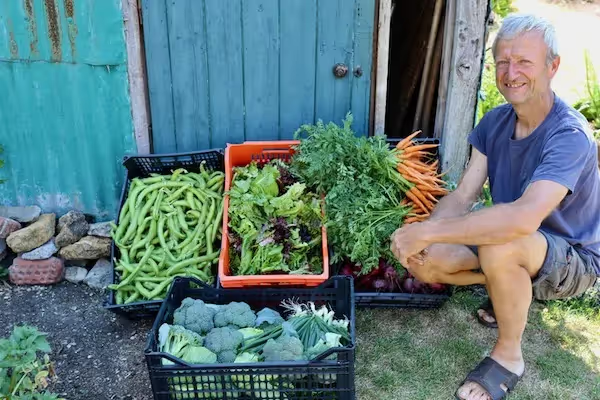June mid month new picking and plantings, intersowing carrots, making and using composts, pyralid weedkiller hidden in composts
Heading

This post is also available in: Français (French)
The weather is cooler and damper than May, but only 28mm/1.1in rain here so far. The soil under growing plants is still dusty – but some of you have had big rain, even too much. “A dripping June keeps all in tune”, within reason.
We have needed to water much less recently. See my watering video for more details. In the polytunnel we water twice a week just now, with daytime temperatures only high teens C/high sixties F.



No dig, keep it simple, see June video
You need simply to keep pulling any weeds as soon as seen, when small. None then go to seed. No dig means many fewer weeds, and easier to remove, Keep pulling bindweed and marestail!
You don’t need to be feeding and fertilising, except for container growing. I received this sobering tale from Jodie:
I went up the allotment this morning to check on everything after the rains, and the fox has dug up 8 of my 9 squash! I have some spare so can mostly fill the space, but that leaves one spare bed. I was going to have 2 beds this year with squash, but alas not! I’m guessing the fox sniffed out the bonemeal I put under the squash. First time I’ve ever used it. I won’t be using it again!



Transplanting
I sowed cabbage and kale on 9th May in a seed tray, we pricked them to modules, and potted them to pots. This keeps them growing while broad/fava beans and spinach are finishing.
Edward helped me to plant them on the evening of 11th June and it was amazing to see how dry the soil is, where broad beans were growing. Next week we are transplanting Brussels sprouts.



Direct sowing
My only direct sowings in summer are carrots, in order to have straight and unforked roots. Finding space for them means often intersowing.
There is carrot root fly just finishing its first hatching, and I have damage to uncovered sowings. Those under fleece and mesh are mostly clean.


Harvests
We created a video on 7th June, and Edward spent a fair time on the editing. I think the quality is as good as you will find anywhere.
In this video I wanted to show how you can tell when to harvest, because it’s not mentioned a lot in garden writing. I cover it in my second online course. Together with advice on planning for succession plantings, and a lot on spacings.



More harvests
Softneck garlic is coming ready over the next two weeks. We harvested the polytunnel garlic on 4th June and this morning I pulled an outdoor garlic which has a lot of rust. It’s ready to pull, has finished swelling. If you leave them in too long after leaves go yellow with rust or age, the outer skin degrades and they look quite ugly.
Hardneck garlic matures often in early July. Look for a ribbed patter of cloves protruding from the bulb, yet still covered with the white outer skin of each bulb.



Planning the next plantings
I put up a video to help, last summer “Garden Planning”. A lot is about timing and spacing.
Find the knowledge of what can be sown when, for succession sowing, on my sowing timeline. Also in Calendar + Diary book offer.



Making compost
We have been short of materials, due to dry weather, and no coffee grounds from cafes. Covid has ramifications in all directions. One nice thing has been neighbours bringing their garden wastes here, after I expressed interest, and because the recycling centre is not much open, with long queues.
If you cut hedges of their new growth, the leaves and green wood are good to compost. Especially if you can mow them. We also have a shredder for woody prunings, such as elder and any shrubs.


Using compost
No need to worry about pH. But often compost is sold too fresh and unripe. For example if it’s warm when you fill beds, is still decomposing and taking nutrients.
By late summer this will cease and things will grow, but new plantings may go yellow, and the compost will be difficult to water, at first. This is sometimes called “burning”.
Perhaps add a little potting compost around plants and in plant holes for now.
There is much confusion about this, such as this question. Few people really understand it.
I received a truck load of communal green waste that is composted by the local area and i was told that it could burn my vegetation but i have no explanation as to why.
Woody material is slowest to decompose, best not bury wood chip in new beds for example. Green wood on a compost heap, such as the willow in these photos, will decompose by autumn.


Aminopyralid and clopyralid
These horrible poisons are causing much distress and problems. If you suffer it, report on the website manurematters.co.uk.
Suppliers whose products have caused problems include Fenland Country Topsoils (probably in horse manure from Newmarket), farmers selling cow manure, Westland (many instances I know of – probably pyralids in lawn weedkillers), Country Natural organic manure – plus the owner is rude when asked about this, and now there are problems with cow manure as well as horse manure.
Grow broad beans in modules of compost to check. See my videos, inform yourself. It’s painful but necessary. The main symptom to check for is tight inward curling of new leaves, resulting in deformed and twisted plants. Even a few parts per billion cause this. Don’t compost the leaves, the poison continues in any heaps, but is dissipated by soil microbes, when laid on top.



Get Charles's advice in his free newsletter
& 10% off your first order in our shop




